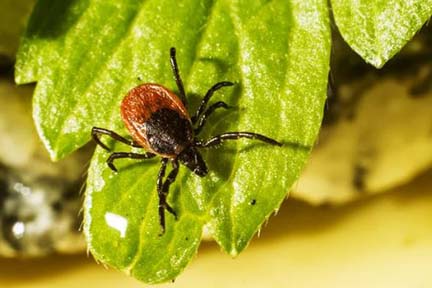Press Release FOR IMMEDIATE RELEASE: April 19, 2023 CONTACT: Chelsea Wuth, 517-241-2112, WuthC@michigan.gov MDHHS educates Michigan residents about how to stay healthy this tick season LANSING, Mich. – The Michigan Department of Health and Human Services (MDHHS) encourages Michigan residents to take steps to avoid tick bites while enjoying the outdoors. Tick-borne diseases, particularly Lyme disease and anaplasmosis, are increasing across the state as weather warms. Ticks can be active when the weather is above 40⁰F. “Preventing tick bites is the best way to prevent tick-borne diseases,” said Dr. Natasha Bagdasarian, MDHHS chief medical executive. “Michigan residents who find a tick attached to their body should promptly remove it and monitor their health. If they begin to experience fever, rash, muscle or joint aches or other symptoms, they should consult a medical provider.” Signs and symptoms of tick-borne disease typically begin one to two weeks after a tick bite, often after being in wooded or brushy areas where ticks commonly live. Early symptoms can be non-specific and include fever or chills, rash, headache, fatigue and muscle aches. Early treatment with appropriate antibiotics can decrease the risk of serious complications. Lyme disease, caused by the bacterium Borrelia burgdorferi, is the most common tick-borne disease in Michigan. Anaplasmosis, caused by the bacteria Anaplasma phagocytophilum, is the second most common tick-borne disease in Michigan and cases are increasing, particularly in the state’s Upper Peninsula. Both Lyme disease and anaplasmosis are transmitted by Ixodes scapularis, commonly known as the blacklegged or deer tick. The blacklegged tick is well-established in parts of Michigan’s Upper and Lower Peninsulas and has been expanding its range over the years. Information about Lyme disease risk by county is available at Michigan.gov/Lyme. People can protect themselves against Lyme disease and other tick-borne diseases by following these tips: Avoid tick-infested areas.
Use insect repellent.
Perform daily tick checks.
Bathe or shower.
The MDHHS Emerging & Zoonotic Infectious Diseases Section has recently released a report “Michigan Trends in Tickborne Disease, 2016-2020,” which includes up-to-date information on the types of ticks that are common in Michigan and the diseases they can carry. Not all ticks spread the same germs. MDHHS can help to identify ticks you may encounter outdoors. Residents can email photos of ticks to MDHHS-Bugs@michigan.gov for identification or submit ticks to MDHHS for identification. For more information on how to submit your tick and/or photos and information on ticks, visit Michigan.gov/Lyme. For more information on Lyme disease, visit CDC.gov/Lyme. |


